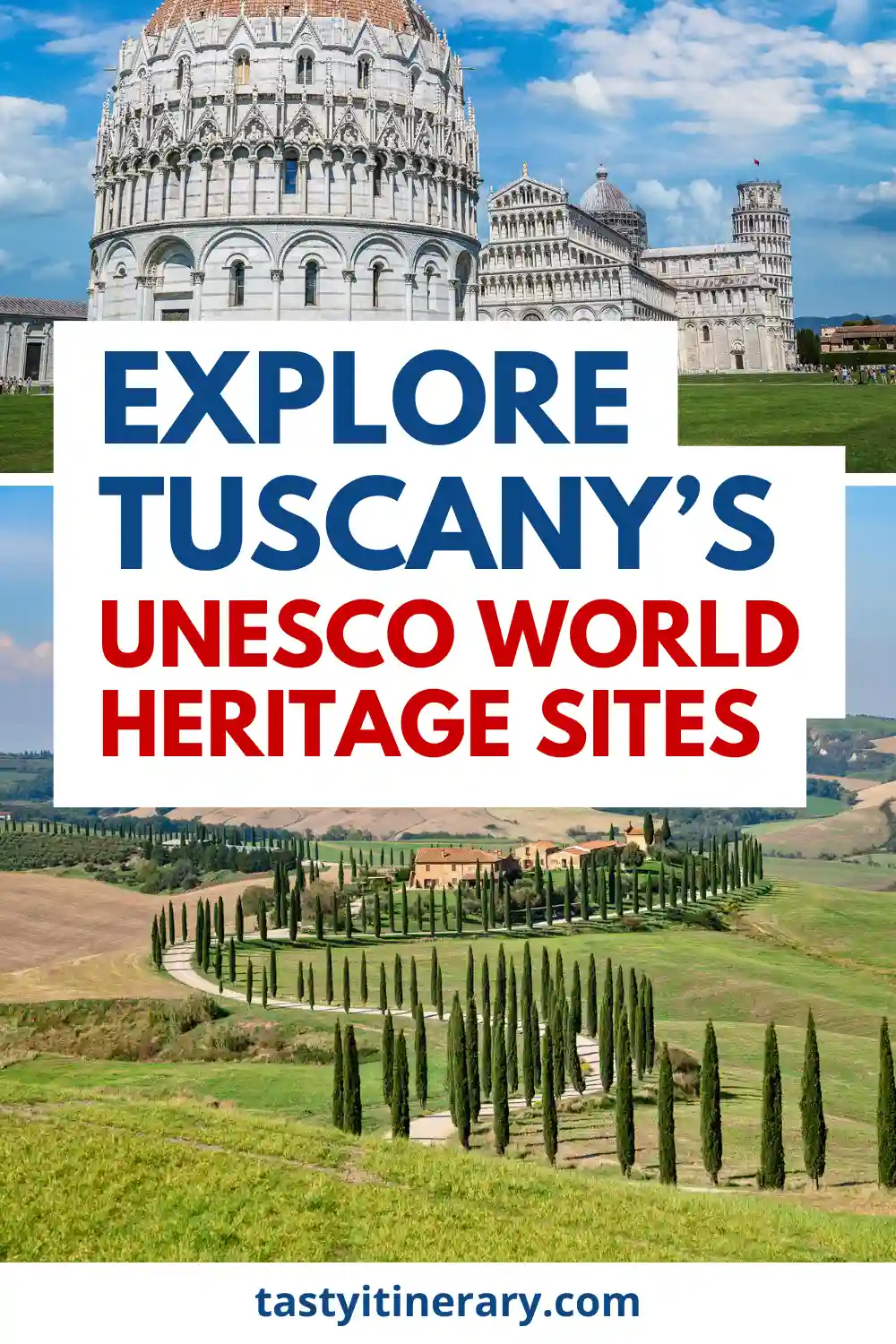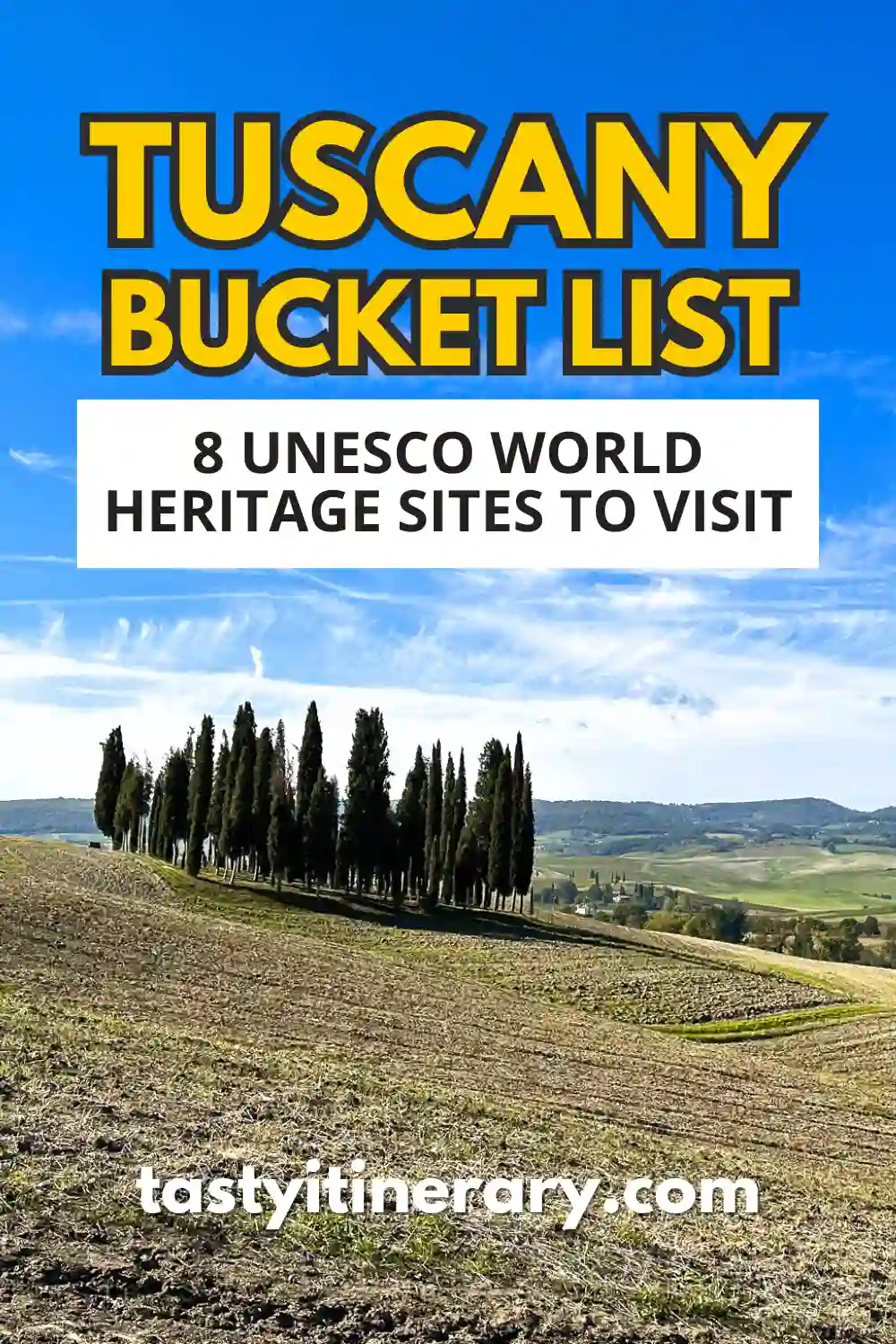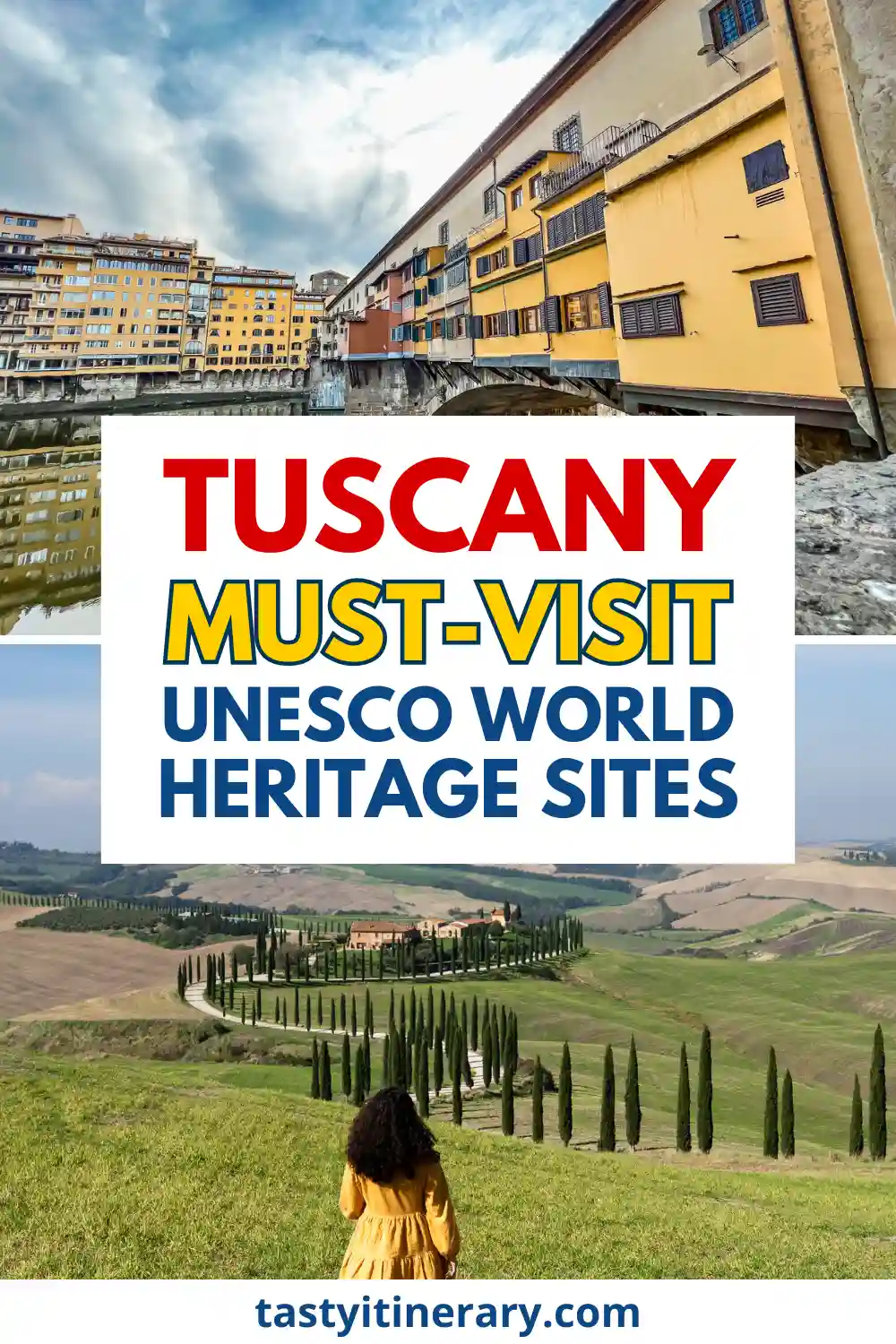Tuscany’s 8 UNESCO World Heritage Sites to Explore
Tuscany is home to eight UNESCO World Heritage Sites, and after visiting a few times, it’s easy to understand why. Between the rolling hills, medieval towns, Renaissance cities, historic villas, and spa towns, every corner of Tuscany feels like a step through history.
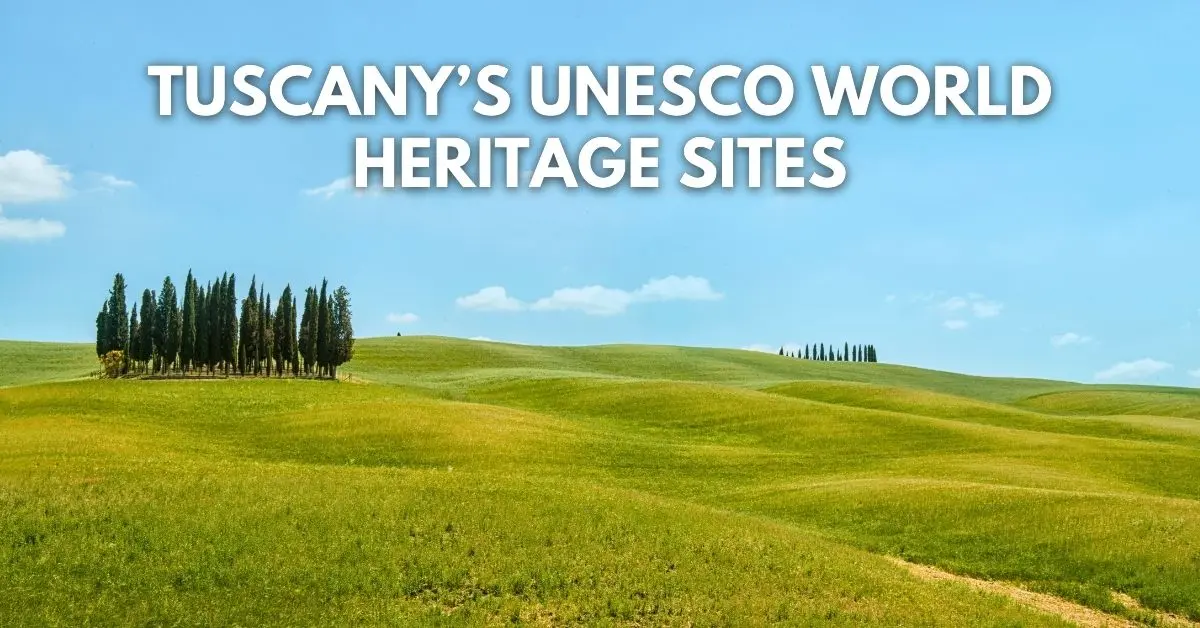
Disclaimer: This post may contain affiliate links, meaning we earn a commission at no extra cost. Please refer to our full disclosure for details.
Italy has 60 UNESCO World Heritage Sites in total, the most of any country. Tuscany proudly claims eight of them, each offering a different glimpse into the region’s art, architecture, landscapes, and traditions.
After a few trips, we realized we had already visited six of the eight UNESCO sites in Tuscany without even trying. If we had been keeping track, we might have made the effort to check off the last two during our recent three days exploring Val d’Orcia and the Tuscan countryside.
Tuscany is one of our favorite regions in Italy. The food, the wine, the views, the history—it keeps pulling us back. We’ve wandered cities like Florence, Pienza, Pisa, Lucca, San Gimignano, and Siena, and even with all that, it still feels like there’s more waiting. You could spend months here and still not see it all.
If you’re planning a trip and trying to figure out what not to miss, visiting Tuscany’s UNESCO World Heritage Sites is a great way to experience some of the region’s most beautiful and historic places — and they fit naturally into almost any Tuscany itinerary.
What is a UNESCO World Heritage Site?
UNESCO stands for the United Nations Educational, Scientific, and Cultural Organization. It works to protect cultural and natural heritage around the world, recognizing places that are important to humanity. Today, there are over 1,000 UNESCO World Heritage Sites across more than 160 countries.
UNESCO World Heritage Sites in Tuscany
We put together a handy Google Map of the eight UNESCO World Heritage Sites in Tuscany to make planning your tasty itinerary a little easier.
Historic Center of Florence
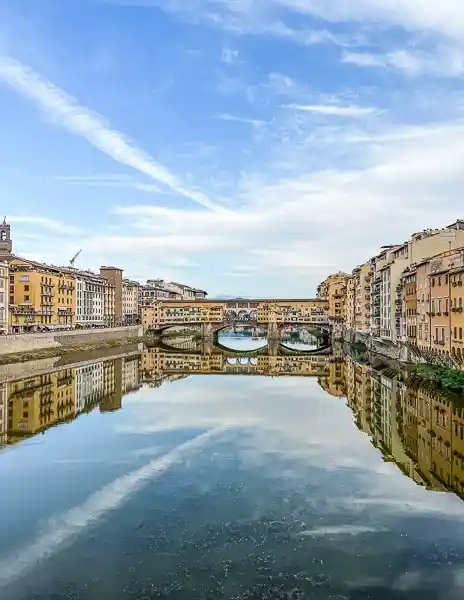
The heart of Florence has stolen a piece of our hearts more than once, so it’s no surprise it’s one of Tuscany’s UNESCO World Heritage Sites.
Recognized by UNESCO in 1982, Florence’s historic center feels like a living museum. From the moment you see the Duomo, the Cathedral of Santa Maria del Fiore, standing tall in Piazza del Duomo, it’s clear why the city is so celebrated. Florence, home to the powerful Medici family, is filled with masterpieces, many of which are housed in the Uffizi Gallery, one of the world’s oldest and most renowned art museums. You’ll find works by Botticelli, Michelangelo, and da Vinci, among others.
There’s even more to see: Michelangelo’s David, the Ponte Vecchio, the Boboli Gardens, the Basilica of Santa Maria Novella, and the Santa Croce Church.
While you can get a glimpse of Florence in a day, we always recommend staying longer. The city is compact, walkable, and packed with delicious food, making it perfect for day trips around Tuscany. Plus, Florence is where gelato was invented—what more could you ask for? If you have time, a food tour in Florence is worth it. One of the food tours we did there ended up being one of our favorite travel experiences.
Tip: Book tickets in advance for popular sites like the Uffizi Gallery, the Galleria dell’Accademia, and Palazzo Vecchio. Lines can get long, and spots often sell out quickly.
Tour Ideas:
Fascinating Florence: Guided Walking Tour [book here]
The History of Florence: The Renaissance Tour [book here]
The Landscape of Val d’Orcia
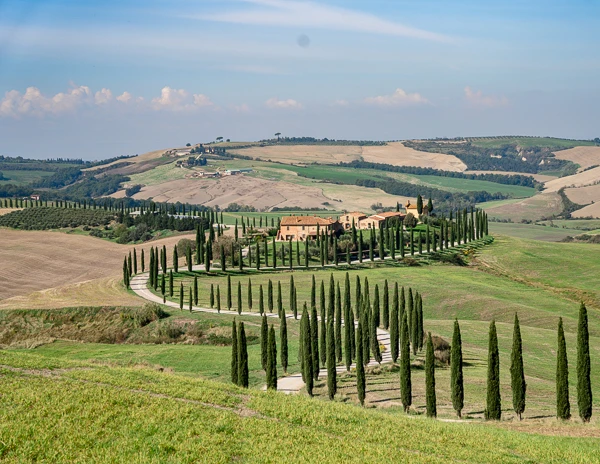
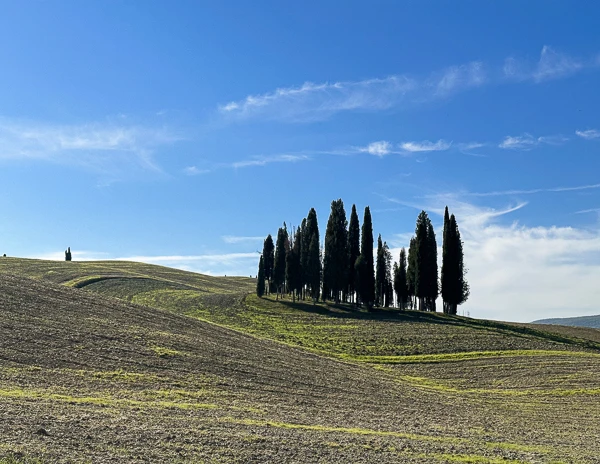
Val d’Orcia is one of the most beautiful and captivating parts of Tuscany. It’s a UNESCO World Heritage Site, recognized for its breathtaking landscape and careful land management dating back to the Renaissance.
Located in southeastern Tuscany, Val d’Orcia feels like stepping into a painting. With rolling hills lined with cypress trees, postcard-perfect villages, farms, vineyards, and olive groves, it’s no wonder it’s considered one of the most photographed places on Earth. Protected since the 14th century, it’s also one of the best-preserved landscapes in Italy.
Val d’Orcia is ideal for a leisurely trip. You can pack a picnic, rent a bike, or simply drive through the countryside. We recommend renting a car to explore freely and visit villages like Montalcino, Pienza, and San Quirico d’Orcia. Along the way, stop at iconic spots like Chiesa di Vitaleta, the tower of Radicofani, and the hot spring pools of Bagno Vignoni.
Another highlight is driving the Crete Senesi loop, where the hills, shaped by erosion, create a surreal landscape dotted with charming villages.
Plan to stay for at least two days or more, if possible. Val d’Orcia is peaceful, beautiful, and every turn feels like a scene from a living painting.
Tour Ideas:
Private Tour of Val d’Orcia from Florence [book here]
Bike Ride Immersion Val d’Orcia [book here]
Historic Center of Pienza
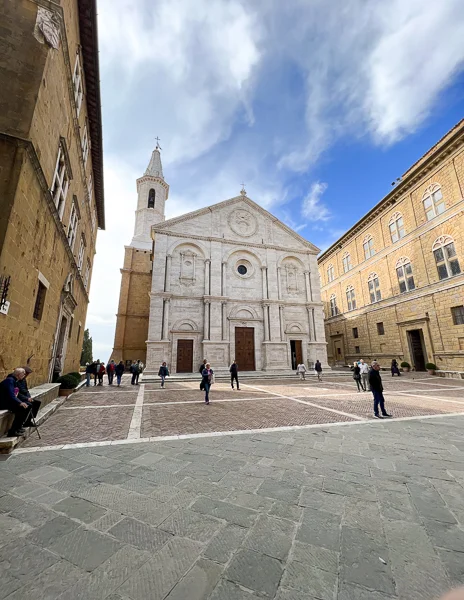
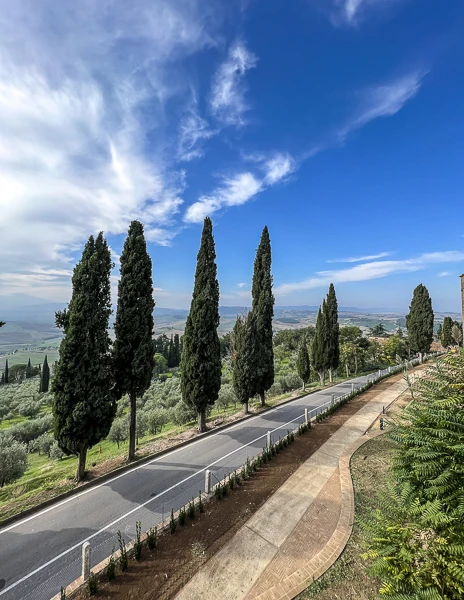
Located in southern Tuscany, the historic center of Pienza was declared a UNESCO World Heritage Site in 1996. It’s one of the most popular destinations in Tuscany, and once you visit, you’ll see why.
Pienza was once a medieval village called Corsignano. In 1459, Pope Pius II decided to transform it into his ideal city, renaming it Pienza, which means “City of the Pius” in Italian.
What makes Pienza so special today is how much of its Renaissance charm has been preserved. You can stroll through the main square, Piazza Pio II, and admire the beautiful architecture, including Palazzo Piccolomini, the Duomo di Pienza Cathedral and its bell tower, and Palazzo Borgia.
Beyond the main square, wander through narrow streets filled with local shops, art galleries, and plenty of spots to sample pecorino cheese, a regional specialty. Don’t miss the chance to walk along the city walls, where you’ll find some of the best panoramic views of the Val d’Orcia. If you stumble upon streets like Via dell’Amore or Via del Bacio, it’s all part of Pienza’s charm.
Pienza is compact and easy to explore in a few hours, but it’s the kind of place you’ll want to slow down and savor.
On one of our trips, we stayed at a B&B in the countryside of Pienza, using it as our base to explore the Val d’Orcia. It was the perfect spot to soak in the region’s beauty at a slower pace.
Siena’s Historic City Center
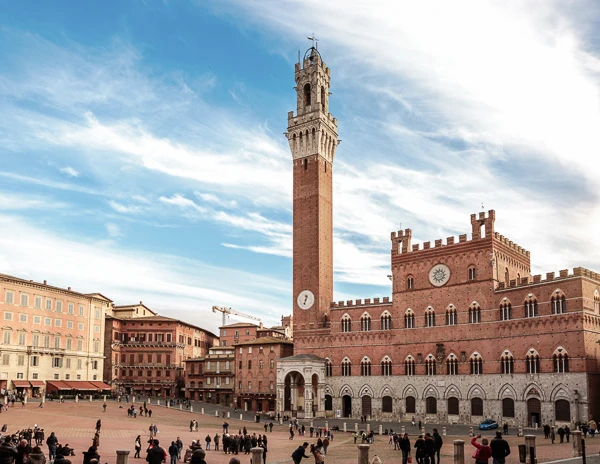
In the heart of Tuscany lies Siena, a centuries-old city declared a UNESCO World Heritage Site in 1995. Its medieval center is a delight to explore, filled with charming streets, Gothic architecture, and a vivid sense of history.
Siena is known for its art, beautiful cathedrals, lively piazzas, and the Palio di Siena, a traditional horse race that brings the city together twice a year. As you wander through the city’s sloping streets, you’ll notice colorful flags and symbols marking Siena’s historic contrade, or neighborhoods, each with its own traditions.
At the center of it all is Piazza del Campo, one of the most famous squares in Italy. Surrounded by centuries-old buildings, the piazza has an atmosphere that feels both grand and welcoming. While you’re there, visit Palazzo Pubblico, climb Torre del Mangia for panoramic views, and admire Fonte Gaia before heading to the Siena Cathedral. The cathedral’s black and white marble columns, intricate mosaic floors, and the frescoes inside the Piccolomini Library are worth stepping inside to see.
The Palio di Siena, held every July and August, is a deep part of the city’s tradition. This age-old horse race transforms Piazza del Campo into a colorful, energetic celebration that draws locals and visitors alike.
Tip: Siena has a central train station, making it easy to connect to other parts of Italy. It’s also a great home base if you want to stay in a larger city while exploring the surrounding Tuscan countryside.
Tour Ideas:
Walking Tour of Siena with Food & Wine [book here]
Vespa Tour, Including Lunch at a Chianti Winery from Siena [book here]
Vintage Fiat 500 Tour from Siena: Tuscan Hills and Winery Lunch [book here]
San Gimignano’s Historic Center
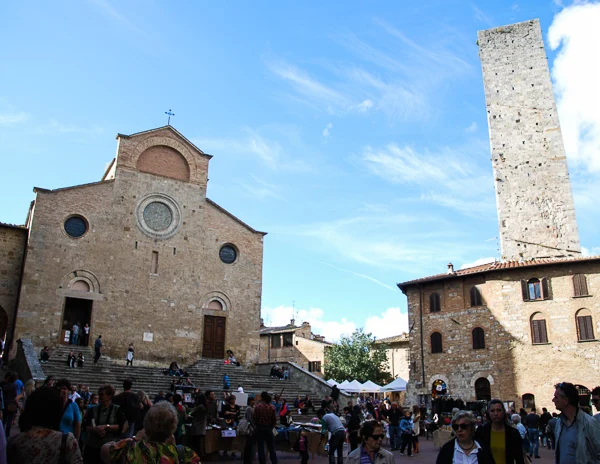
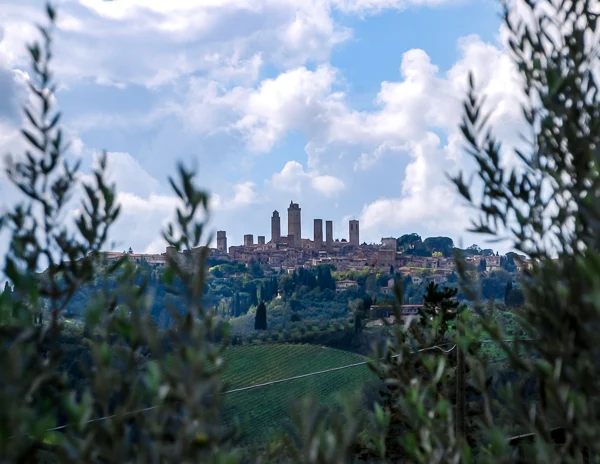
San Gimignano, a small walled city set in the hills of Tuscany, was declared a UNESCO World Heritage Site in 1990. It’s famous for its medieval architecture and its skyline of soaring towers, creating one of the most distinctive views in Italy, like a medieval Manhattan in the Tuscan countryside.
Known as “The City of Towers,” San Gimignano earned its nickname in the 13th century when wealthy families built tower houses to show off their power. At its peak, there were more than 70 towers; today, 14 still stand, visible from miles away. San Gimignano is also one of the best-preserved examples of a medieval town layout, which is part of what makes it a UNESCO-listed site.
Wander through the cobblestone streets, explore Piazza della Cisterna, and admire the frescoes inside Sant’Agostino. If you’re up for it, you can also climb Torre Grossa, the tallest tower, for sweeping views over the Tuscan countryside.
While you’re there, stop at Gelateria Dondoli to try their award-winning gelato, and sample the local Vernaccia di San Gimignano wine at one of the town’s cozy wine bars. You don’t need much time to enjoy San Gimignano’s charm — even a few hours is enough to leave an impression.
Tip: San Gimignano makes a great day trip from Siena, but you’ll need a car to get there.
Tour Ideas:
San Gimignano, Chianti, and Montalcino Day Trip from Siena [book here]
San Gimignano: Original & Fun Wine Tour in Chianti by TukTuk [book here]
Piazza dei Miracoli (Square of Miracles), Pisa
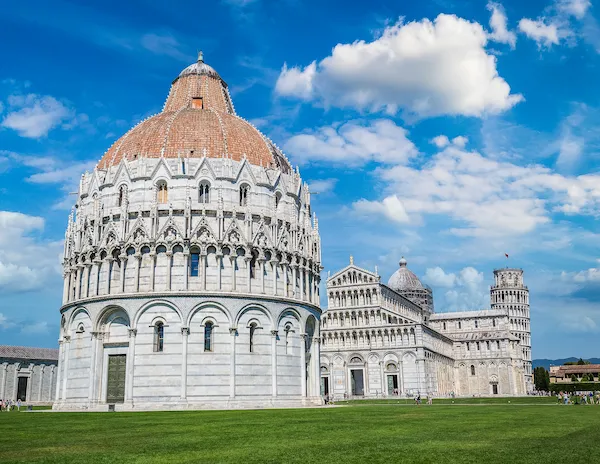
This UNESCO World Heritage Site is located in Piazza del Duomo, better known today as Piazza dei Miracoli, a beautiful square surrounded by historic landmarks: the Leaning Tower of Pisa, the Baptistery, the Cathedral, and the Camposanto Monumentale, a landmark cemetery lined with frescoes. It earned the nickname “Square of Miracles” for its breathtaking architecture and sense of wonder.
The Leaning Tower of Pisa is one of the most famous landmarks in Tuscany — and the world. Dating back to 1173, the tower began leaning during construction when builders reached the third story and realized the soft ground couldn’t support its weight. Today, you can climb its 251 steps for a unique experience and incredible views.
The Baptistery and the Cathedral are also part of the UNESCO World Heritage site. The Baptistery, dedicated to St. John the Baptist, dates back to 1152 and features a striking circular design and ornate decoration. The Cathedral, dedicated to St. Mary of the Assumption, is a stunning blend of Romanesque and Gothic styles, featuring marble sculptures, intricate mosaics, and an elaborately carved pulpit within.
Most people visit Pisa on a day trip, often to check the Leaning Tower off their bucket list. If you’ve never been, it’s worth the stop. If you plan to climb the tower, booking tickets in advance is a good idea.
Tip: Pisa is easy to reach by train or bus from cities like Florence, Lucca, Siena, and other parts of Tuscany.
Tour Ideas:
Private Pisa Discovery Walking Tour with Leaning Tower Access [book here]
Small Group Golf Cart Tour in Pisa [book here]
Medici Villas and Gardens
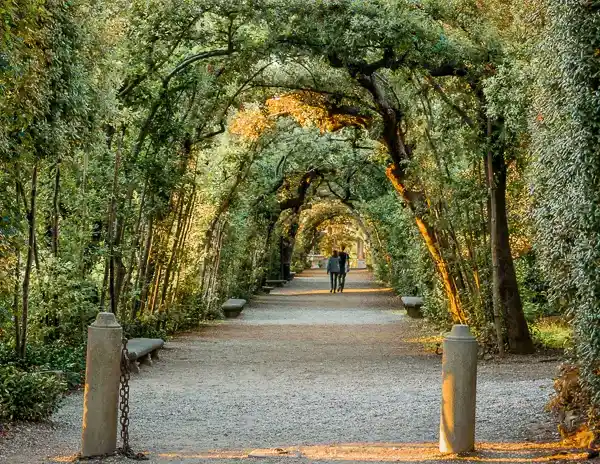
The Medici family was one of the most influential dynasties in Italy, ruling the Florentine Republic for centuries and leaving a lasting legacy through their contributions to art, architecture, and culture across Tuscany.
The Medici Villas and Gardens, a collection of 12 villas and 2 gardens, were added to the UNESCO World Heritage list in 2013. Spread across the Tuscan countryside, they reflect the connection between architecture, landscape design, and Renaissance ideals — a style that would influence garden planning across Europe.
If you’ve visited Florence, you might have already walked through the Boboli Gardens, located behind the Pitti Palace, filled with sculptures, fountains, and shaded pathways. It’s one of the best-known examples of the Medici’s love for grand, carefully curated spaces. Other notable Medici villas include Villa La Petraia and Villa di Castello, both near Florence.
Note: Some villas are open to the public, while others require reservations, and some have been converted into private residences, resorts, or museums.
- Villa Medici de Fiesole
- Villa de Cafaggiolo
- Villa Medicea del Trebbio
- Villa de Artimino
- Villa de Castello
- Villa Medicea de la Petraia
- Villa di Careggi
- Villa de Cerreto Guidi
- Palazzo di Seravezza
- Villa Medicea La Magia
- Villa du Poggio Imperiale
- Villa de Poggio a Caiano
Montecatini Terme
Montecatini Terme, located in central Tuscany between Lucca and Pistoia, is one of 11 towns recognized as part of the UNESCO World Heritage Site “Great Spa Towns of Europe.”
Known for its warm saline baths with healing properties, Montecatini Terme has long been a destination for relaxation. In its golden age, it was a favorite retreat for European royalty and artists looking to “take the waters.” One of the highlights is Terme Tettuccio, a historic spa with grand colonnades, mineral springs, and beautiful architecture.
Today, Montecatini Terme blends old-world elegance with modern comforts, offering visitors a chance to stroll through charming streets, unwind at its many spa resorts, and enjoy the peaceful Tuscan countryside. It’s an easy day trip from cities like Florence, Lucca, and Pisa.
Tip: Many cities in Tuscany are easy to reach from Montecatini Terme by train or bus. Florence, for example, is just about an hour away by train.
Tour Idea:
Montecatini Terme Cycle & Wine Tasting Visit [book here]
BEFORE YOU TRAVEL TO ITALY, CHECK OUT THESE RELATED READS:
- Exploring Val d’Orcia and More in 3 Days
- Experiences in Italy I Still Think About
- Why Italy Belongs on Your Travel List
- Italy Quotes That Will Make You Crave a Trip
Kathy Ava
Meet Kathy Ava, a food, travel, and cruise writer based in Los Angeles/Pasadena, and the owner and main writer of Tasty Itinerary. With over 20 years of experience planning trips and logistics at her full-time job and for herself, she's become a pro at crafting unforgettable tasty itineraries. She's always on the hunt for delicious, fun travel destinations and cruise itineraries. She firmly believes that life is short and we must make the most of it, so always say yes to dessert.

